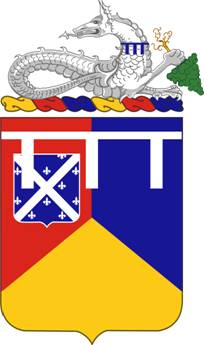
The 66th Armor Regiment is the oldest armored unit in the United States Army, tracing its lineage to the 301st Tank Battalion which served with distinction soon after it was formed in the First World War; the 301st trained at Camp Meade, Maryland, where then Cpt. Dwight D. Eisenhower was an instructor. It has often been rumored that the 301st, the parent unit of the 66th, was first commanded by Col. George S. Patton, but this appears not to have been the case; while Patton was the first officer assigned to the Tank Corps, and while the 301st Tank Battalion was the first unit formed, Patton went nearly immediately to France to train Americans attached to Allied commands. The 301st was the only American heavy tank battalion to have seen action in the war. After the war, the 301st transitioned in the Regular Army to become the 66th Infantry Regiment by way of the 16th Tank Battalion.

The 37th Infantry Brigade Combat Team (Buckeye) is an infantry brigade combat team of the United States Army National Guard with the brigade headquarters, cavalry squadron, infantry battalion, field artillery battalion, engineer battalion, and support battalion stationed in Ohio, infantry battalion and military intelligence company stationed in Michigan, and a third infantry battalion stationed in South Carolina. The 37th IBCT traces its lineage and honors back to the 37th Infantry Division.
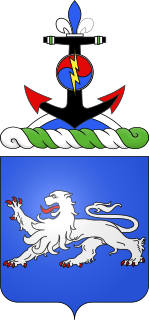
The 68th Armor Regiment is an armored regiment of the United States Army. It was first activated in 1933 in the Regular Army as the 68th Infantry Regiment.
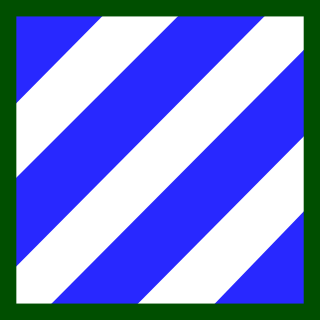
The 48th Infantry Brigade Combat Team is a modular infantry brigade of the Georgia Army National Guard. One of the oldest units in U.S. Army history, the lineage of the 48th Infantry Brigade can be traced back to 1825. It is one of few units in the US military that also saw service as a unit of the Confederate States of America during the American Civil War. Today, the 48th IBCT is part of the U.S. Army's "Associated Units" program where it's aligned under the 3rd Infantry Division, a combined arms combat maneuver unit of the Regular Army.
The 64th Armor Regiment is an armor regiment of the United States Army, organized under the United States Army Regimental System. It is descended from the 758th Tank Battalion (Light) that served in the Italian campaign during World War II. Redesignated as the 64th Tank Battalion, it was assigned to the 3rd Infantry Division during the Korean War and it spent most of the Cold War stationed in West Germany before elements were transferred to Ft. Stewart, Georgia in the late 1990s. The regiment participated in Desert Shield, Desert Storm, Desert Fox, Desert Spring, Operation Iraqi Freedom and Operation Enduring Freedom.

The 185th Infantry Regiment is a unit of the United States Army made up of soldiers from the California Army National Guard, represented by the 1st Battalion, part of the 81st Stryker Brigade Combat Team.
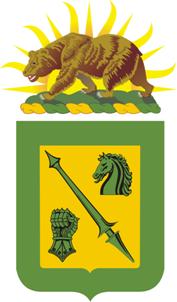
The 18th Cavalry Regiment is a parent cavalry regiment of the United States Army.

The 40th Armored Division was a division of the United States Army National Guard from July 1954 until 1967.

The 116th Cavalry Brigade Combat Team is the largest formation of the Idaho Army National Guard. It is headquartered at Gowen Field, Boise, Idaho. It has been reorganized into an Armored Brigade Combat Team (ABCT) but remains the only unit to be designated a "Cavalry Brigade Combat Team" by special appointment of the US Army. The 116th Cavalry Brigade Combat Team has units located throughout Idaho, Montana, Oregon, and Nevada. It was reorganized into a heavy armor brigade in 1989. Often referred to as the Snake River Brigade and formerly known as the 116th Armored Cavalry Regiment, the unit includes about 3,000 citizen-soldiers from Idaho.
The 67th Armored Regiment is an armored regiment in the United States Army. The regiment was first formed in 1929 in the Regular Army as the 2nd Tank Regiment (Heavy) and redesignated as the 67th Infantry Regiment in 1932. It first became the 67th Armor in 1940. The regiment participated in World War I, World War II, Desert Storm/Desert Shield, Operation Iraqi Freedom, Operation Enduring Freedom, Operation Spartan Shield, Operation Inherent Resolve, Operation Resolute Support, and Operation Freedom's Sentinel.

The 103rd Armor Regiment is an armored regiment in the Pennsylvania National Guard first formed in 1941. Its legacy unit, 3rd Battalion, 103rd Armor, is a subordinate command of the 55th Heavy Brigade Combat Team, 28th Infantry Division.

The 160th Infantry Regiment is an infantry regiment of the United States Army. The 1st Battalion, 160th Infantry is a light infantry component of the 79th Infantry Brigade Combat Team (IBCT).

The 107th Cavalry Regiment, Ohio Army National Guard, is a parent regiment under the U.S. Army Regimental System, with headquarters at Hamilton, Ohio. It currently consists of the 2nd Squadron, 107th Cavalry Regiment, part of the 37th Infantry Brigade Combat Team (BUCKEYE), Ohio National Guard located throughout southwest Ohio.

The 133rd Field Artillery Regiment is a parent field artillery regiment of the United States Army National Guard. It is currently represented in the Texas Army National Guard by the 1st, 3rd, and 4th Battalions.

The 1st Battalion, 160th Field Artillery Regiment is headquartered in Chandler, Oklahoma. It is a part of the 45th Infantry Brigade Combat Team, Oklahoma Army National Guard.

The 45th Fires Brigade is a modular field artillery brigade of the United States Army headquartered in Mustang, Oklahoma. It is a part of the Oklahoma Army National Guard.
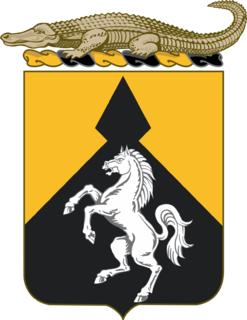
First Squadron, 153rd Cavalry Regiment "Darkhorse" is an element of the Florida Army National Guard, headquartered in Panama City, Florida with units throughout the Panhandle. It was formerly 3rd Battalion, 124th Infantry and officially converted to cavalry on 1 September 2007 when the 53rd Infantry Brigade converted from a "separate brigade" to the brigade combat team structure.
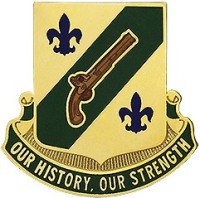
The 117th Military Police Battalion Combat Support (CS), is a military police battalion of the Tennessee Army National Guard (TNARNG) and the United States Army Military Police Corps with its headquarters located in Athens, Tennessee. When not mobilized or deployed, the 117th MP BN is task organized as a subordinate battalion of the Tennessee Army National Guard’s 194th Engineer Brigade located in Jackson, Tennessee.
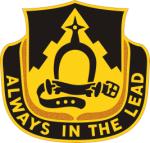
The 303rd Cavalry Regiment is a United States cavalry regiment, currently represented in the Washington Army National Guard by the 1st Squadron, 303rd Cavalry, headquartered at Vancouver, Washington, part of the 96th Troop Command. It incorporates the lineage of the 303rd Cavalry, 303rd Armor, and 803rd Armor Regiments of the Washington Army National Guard.

The 94th Cavalry Regiment is a United States Army cavalry regiment, represented in the Minnesota Army National Guard by 1st Squadron, 94th Cavalry, part of the 1st Armored Brigade Combat Team, 34th Infantry Division, stationed at Duluth.




















